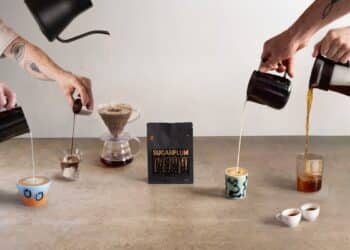Pablo & Rusty’s Operations Manager Chris Tate reveals why selling retail coffee should be a priority for cafés.
We recently surveyed 850 Australians to better understand their coffee habits. One standout result was that almost a third of people (30 per cent) that own an espresso machine told us they prefer to buy their coffee beans directly from cafés to brew at home. Yet many cafés still aren’t leaning into taking beans and other retail products seriously.
Why retail shelves matter
Shelf space in a café is at a premium and it’s often limited. The space needs to make money, and stocking retail coffee is one of the simplest and highest margin ways to do that. If your shelves are filled with low margin items or clutter, they aren’t working as hard for you as they could.
The trust factor: your baristas are your best salespeople
Your baristas are already trusted voices in your business. They make the coffee, they know the flavour profiles, and customers see them as experts. That puts them in the perfect position to recommend coffee for home.
When a barista says, “if you like this blend in your flat white, it goes great in your home espresso or even a moka pot…” it doesn’t sound like a sales pitch, just advice from someone who knows what they are talking about.
Training your team to talk about coffee at home confidently and giving them a chance to taste and brew at home themselves will also turn them into your most effective retail sales advocates.
From a single coffee to a bigger sale
A flat white in Australia should cost a minimum of $5.50. That same moment can become a $65 sale when a guest decides to take home a kilogram of beans.
Selling beans doesn’t cannibalise in-store sales. In fact, it does the opposite – it’ll boost them. Customers who brew at home are more connected to your café, not less. They will come back more often because they feel part of your community.
Convenience is king
When customers are ready to buy beans, they want it to be easy. Supermarkets may have more options and discounted ranges, but cafés win on freshness, trust, and convenience. Guests are already in your venue, enjoying your product, and engaged with your team.
Make beans visible, priced clearly, and easy to grab on the way out. That simple act of convenience can turn a casual flat white customer into a loyal flat white and bean customer.
Don’t underestimate single origins and seasonal coffees
In Australia, less than 10 per cent of customers enjoy their coffee as a black (without milk) espresso, long black or filter, however, this is growing. Single origins taste great as black coffee, but some of them also taste unique and delicious in milk. Single origin, micro lots, and super special coffee such as our expedition program also signal to your customers that you take coffee seriously.
Anecdotally, many a time, a customer tastes a delicious coffee and then decides to buy a bag of it for themselves or their friends.
Practical steps to lift retail coffee sales:
- Placement: Position beans where customers can see them, ideally near the register or pickup counter.
- Clarity: Pricing should be clear and visible. No one should have to ask.
- Staff prompts: Encourage your team to naturally mention coffee for home. For example: “If you enjoyed that single origin, we have bags available on the shelf too.”
- Seasonal offers: Use signage or menu notes to highlight limited releases or new single origins.
Final thought
Café teams already work incredibly hard to deliver great coffee and hospitality experiences every day. The challenge is making sure your space works just as hard for you. Stocking beans on your shelves is one way to do that – a small shift that builds loyalty, drives new revenue, and meets a demand your customers are already telling us exists.
Our survey findings are clear: Australians want to buy beans directly from the cafés they trust. This is just one of many insights we’ll continue to share to help you strengthen your café business and community.

Article written by Chris Tate, Operations Manager of Pablo & Rusty’s Coffee Roasters. Content originally published on the Pablo & Rusty’s website. For more information, click here.




